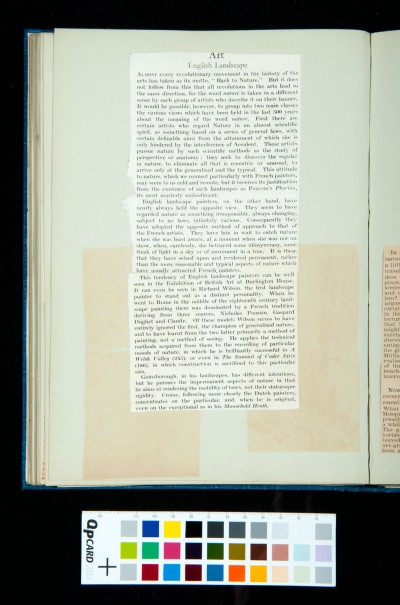Cotmania. Vol. IX. 1933-4
Archive: SDK Sydney Decimus Kitson Archive
Reference Number: SDK/1/2/1/9
Page: p. 19 verso
-
Description
Clipping with header 'Art' and subheading 'English Landscape'
Clipping with header 'Art' and subheading 'English Landscape'
Date: 1933-1934
-
Transcription
Art
English LandscapeALMOST every revolutionary movement in the history of the arts has taken as its motto, "Back to Nature." But it does not follow from this that all revolutions in the arts lead in the same direction, for the word nature is taken in a different, sense by each group of artists who inscribe it on their banner. lt would be possible, however, to group into two main classes the various views which have been held in the last 500 years about the meaning of the word nature. First there are certain artists who regard Nature in an almost scientific spirit, as something based on a series of general laws, with certain definable aims from the attainment of which she is only hindered by the interference of Accident. These artists pursue nature by such scientific methods as the study perspective or anatomy : they seek to discover the regular in nature, to eliminate all that is eccentric or unusual, to arrive only at the generalized and the typical. This attitude to nature, which we connect particularly with French painters, may seem to us cold and remote, but it receives its justification from the existence of such landscapes as Poussin's Phocion, its most masterly embodiment.
English landscape painters, on the other hand, have nearly always held the opposite view. They seem to have regarded nature as something irresponsible, always changing, subject to no laws, infinitely various. Consequently they have adopted the opposite method of approach to that of the French artists. They have lain in wait to catch nature when she was least aware, at a moment when she was not on show, when, carelessly, she betrayed some idiosyncrasy, some freak of light in a sky or of movement in a tree. It is these that they have seized upon and rendered permanent rather than the more reasonable and typical aspects of nature which have usually attracted French, painters.
This tendency of English landscape painters can be well seen in the Exhibition of British Art at Burlington House, well can even be seen in Richard Wilson, the first landscape painter to stand out as a distinct personality. When he went to Rome in the middle of the eighteenth century landscape painting there was dominated by a French tradition deriving from three sources, Nicholas Poussin, Gaspard Dughet and Claude. Of these model Wilson seems to have entirely ignored the first, the champion of generalized nature, and to have learnt from the two latter primarily a method of painting, not a method of seeing, lie applies the technical methods acquired from them to the recording of particular moods of nature, in which lie is brilliantly successful in A Welsh Valley (245), or even in The Summit of Cadet Idrix (186), in which construction is sacrificed to this particular aim.
Gainsborough, in his landscapes, has different intentions, but lie pursues the impermanent aspects of nature in that he aims at rendering the mobility of trees, not their statuesque rigidity. Crome, following more closely the Dutch painters, concentrates on the particular, and, when he is original, even on the exceptional as in his Mousehold Heath.
